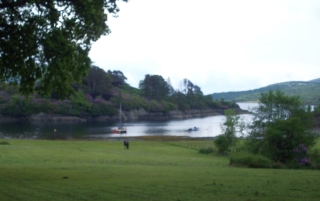The arrival of the warmest weather this year has seen fit to bless us with has coincided with our floating around an idyllic natural playground apparently made just with the boating enthusiast in mind.
We find ourselves asking 'Where is everyone?' because surely there is not a sailor in the world who would not yearn for such a vast area of deep yet sheltered water. Here there are islands to explore, places to drop the anchor, beautiful sunsets, clean sea breezes to breathe in and mile upon mile of water to sail in. There must be a catch or else every inch would be full to bursting with holiday-makers. It occurs to us that perhaps we are experiencing the brochure writers' weather rather than the norm, but who are we to complain.
We find ourselves asking 'Where is everyone?' because surely there is not a sailor in the world who would not yearn for such a vast area of deep yet sheltered water. Here there are islands to explore, places to drop the anchor, beautiful sunsets, clean sea breezes to breathe in and mile upon mile of water to sail in. There must be a catch or else every inch would be full to bursting with holiday-makers. It occurs to us that perhaps we are experiencing the brochure writers' weather rather than the norm, but who are we to complain.
The deep channels, carved out long ago by glacial erosion, steep-sided with only slim stony beaches, are scattered with dwellings that have an apparent air of prosperity, something we find difficult to adjust to after so long in the Western Isles. Although the predominant colour scheme is still grey slates with whitewashed walls, houses dotted along the shoreline are taller and grander here, evidence of wealth speaking more plainly and ostentatiously. To understand the history of what we are seeing we have to go back to about 1820 when paddle steamers began making summer trips from Glasgow. With a fast train service from the city centre to the Clyde ports and regular scheduled steamers serving the whole of the Clyde estuary this area could almost be described as 'commuter belt'. The heavily indented coastline makes travel by land convoluted and difficult but for over 100 years travel became possible for the masses and towns like Rothesay on Bute expanded into Victorian grandeur. For many years the wealthy built their holiday or weekend getaways here, grand palaces or more moderate hideaways, taking advantage of the relative peace and quiet. These houses still remain but as roads and cars proliferated the steamers became redundant and by the 1950s all had been replaced by inter-island ferries.
The land is thickly wooded, both Scots pine and deciduous trees growing on equal terms, and everywhere there is the pale purple of rhododendron in flower, an invading plant that tries to choke the life out of much of the indigenous flora but adds startling colour to the landscape.
Cirrus drifts about from place to place, light breezes dominating the early part of the day then wind arriving from any direction, least of all that forecasted. I assume my favourite spot at the bow, legs dangling just above the water as our auto-helm steers us between island and shore, although it is often difficult to remember which is which. At Kames on the Cowal peninsula we shop for provisions so we can continue our circuit of the Isle of Bute whose sides plunge steeply into the Kyles on each side. Once again we make use of moorings that are provided by the local hotel, which offers an impressive menu to attract its customers.
We stay only one night as we have a much quieter spot in mind. An Caladh is a tiny natural harbour tucked away behind Eilean Dubh, one of many islands of this name.
On shore here there was once a very grand house, a veritable castle designed by Robert Stevenson no less, but after it was later abandoned, the building deteriorated to such an extent that it was eventually demolished by the army as a weekend training exercise. There remains little more than a pile of stones today but the view down the East Kyle, presumably what attracted the wealthy owner in the first place, is just as stunning as ever.
On shore here there was once a very grand house, a veritable castle designed by Robert Stevenson no less, but after it was later abandoned, the building deteriorated to such an extent that it was eventually demolished by the army as a weekend training exercise. There remains little more than a pile of stones today but the view down the East Kyle, presumably what attracted the wealthy owner in the first place, is just as stunning as ever.
Passing by on the shore path was a young lady attempting to walk the entire British coastline, for charity, starting and ending in London, apparently a distance of over 7,000 miles. Her task is a formidable one and in this area where the land bends north and south every few miles this must be terribly frustrating. It occurred to me that our own journey by sea would be doing something similar if we ducked in and out of every watery wrinkle and slipped behind every island.
After two nights at anchor alone in An Caladh there is a change in the weather, 24 hours of solid rain and a brisk north-easterly whining through the rigging. Out come our woollen jumpers and socks again as we prepare ourselves to move on. Perhaps we have discovered for ourselves the reason this area remains so beautifully unspoilt.



No comments:
Post a Comment